Australia's first De Forest phonofilm
A royal visit to Australia early in 1927 provided an excellent opportunity to produce the first Australian motion picture with viable sound-on-film.
The (English) Duke and Duchess of York came to the country late in March 1927, with the main objective of opening the newly-built Federal Parliament building in the Federal capital of Canberra. While here they also visited all state capital cities and some country towns and areas.
In mid-1925, De Forest Phonofilms (Australia) Limited was incorporated, with the object of producing motion pictures with sound-on-film using the process devised and patented by the American inventor Dr. Lee de Forest. The general manager of De Forest Phonofilms (Australia) was Stanley William Hawkins, a retired army captain who had set himself up in business in Sydney after World War 1.
The camera, microphones, mixing panels, and other electronics that would enable the taking of phonofilms arrived in Sydney on 17 March 1927 on board the City of Yokohama from New York. After several days' delay for customs clearance, Hawkins and company had less than a week before the arrival of the Duke and Duchess to learn how to use the equipment to record sound along with images. They had on their staff Harry West Jones, a De Forest engineer who had been in Australia since September 1926, and who had helped to set up their studios and to train their staff, and who would now get the camera and sound recording gear in working order.
The reception of the Duke and Duchess of York at Farm Cove, Sydney
The Duke and Duchess of York arrived in Sydney Harbour aboard the Royal Navy battle-cruiser H.M.S. Renown on the morning of Saturday, 26 March 1927. They were taken by Royal barge from the Renown, which was moored in the harbour, to a landing pontoon specially set up at Farm Cove. There was much formality to their reception to Australia, some being done on the Renown, some on the pontoon, and some after they had finally stepped on to land.
The photograph below shows the scene at Farm Cove as the reception took place. On the right is the pontoon; in the centre is an arbour (or welcome arch), through which is a gangway, whose railings can be seen, that links the pontoon to a ramp that leads to terra firma. Beyond the gangway and ramp is an open area next to the rotunda (or pavilion), seen on the left. The arbour, gangway, ramp, and rotunda are all seen in the phonofilm. All of the welcoming ceremony captured on the film takes place in the area between the arbour and the rotunda.
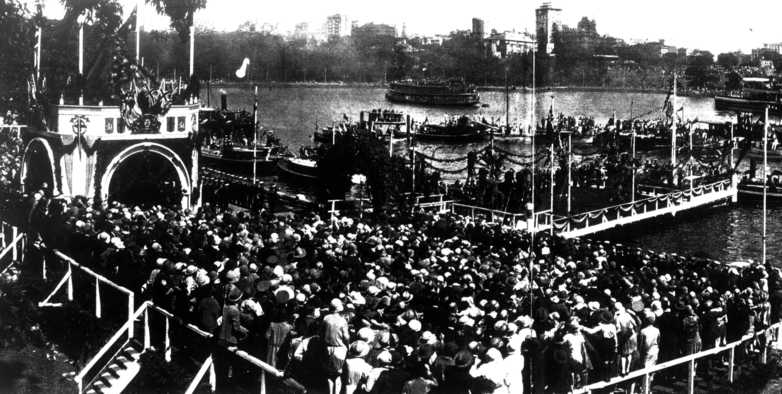
N.S.W. welcomes the Royal visitors
The aerial view below shows the reception area in the middle of the image between the ramp and the rotunda. The western end of the pontoon and the gangway, with the arbour over it, leading to the ramp, are on the right.
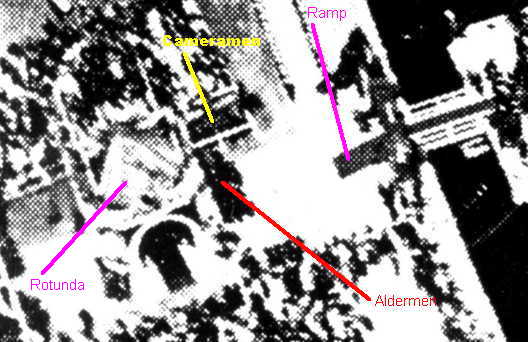
Aerial view of reception area on land
At some time before 7 March 1927 Hawkins applied to the NSW Government to film at the landing, and on this date was given permission to do so along with an allocation of space in the reserve set aside for cinematographers near the south-western corner of the rotunda. This reserve area can be seen in the aerial view above, where the cameramen are indicated.
The original plan for the reception by the Lord Mayor of Sydney was to have him deliver his address of welcome inside the rotunda, but on 7 March it was decided that the address be instead made on its steps. The main motivation for this change was that the public, cinematographers, and still photographers would get a better view, with more light, outside rather than in.
The whole scene where the Lord Mayor's reception took place is shown in the photograph3 below. This was taken from the pontoon at the time the Duke had gone to inspect the Naval Guard of Honour (which is to the right of the scene in the image). In the foreground are the gangway and ramp, on which are standing the Duchess and the Governor of New South Wales, Dudley de Chair; the arbour partially frames the view; in the middle distance are the aldermen of the City of Sydney with the rotunda behind them; through the rotunda's arches can be seen steps (now called the Fleet Steps) leading up to the road by which the royal entourage would leave; and on the right is the cameramen's reserve, in which cinecameras can be seen, including that of De Forest Phonofilms which is the leftmost one, with the prominent tripod leg to the right of the Duchess. (Walter H.B. Sully, who was operating the camera, is unfortunately hidden by the camera next to him.4)
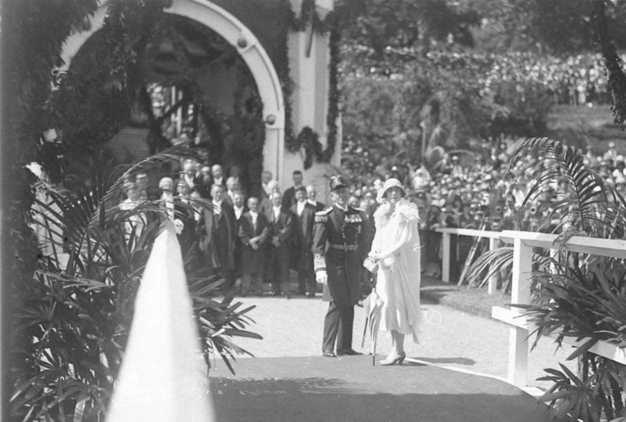
The Duchess of York and NSW Governor de Chair
(Photograph by Sam Hood)
In the photograph below the Lord Mayor of Sydney, John Harold Mostyn, on the left, is reading his address of welcome to the Duke and Duchess, who are facing him. (The back of the Duchess' head is in the centre of the image.) The aldermen of Sydney, some standing on the steps of the rotunda, are at the rear of the scene. A microphone can be seen on the right above the Governor's cocked hat. This microphone is briefly seen in the film at the time the party climb the steps to the rotunda. The position of the Phonofilms camera was to the right of this scene, and pointing such that the Lord Mayor and the Duke and Duchess, viewed from the side, are in centre frame. (The alderman with his head bowed, to the left of the microphone, is seen in the foreground in the film when the Duke reads his reply speech.)
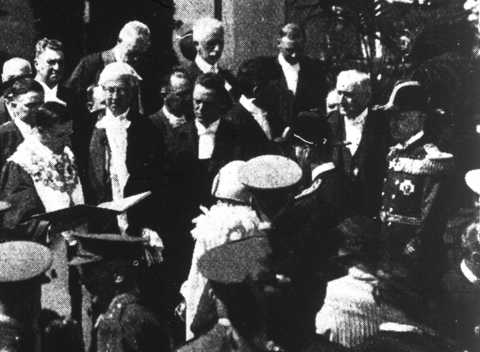
The Lord Mayor welcomes the Royal visitors to Sydney
Given that the Phonofilms camera is not far away, and it was expected that the welcome speeches would be made on the rotunda steps, this microphone must be the one used by Phonofilms in their attempt to capture the speeches.
But it would have been awkward for the Duke and Lord Mayor to move through
the group of aldermen and mount the narrow steps of the rotunda, so their speeches
took place on the ground, further from the microphone than had been planned,
and their voices were too faint to be intelligible above the considerable background noise.
(A newspaper commentator reported that the Lord Mayor's voice
was lost in the great crowd
.)
Did Hawkins and co. try to move their microphone closer to the action?
One report stated:
Men with cameras and the new phono-film were neither meek nor lowly, and had
to be spoken to by the M.C.'s.
Various still photographers are seen in the background when the Duke reads his
reply, and they have moved outside the boundary railing of their reserve
to be closer to their subject.
Maybe a Phonofilms operator attempted to get the microphone nearer
the speakers and was told to get back.
Descriptions of the scenes in the film
- The film opens with a long-shot of H.M.S. Renown moored in Sydney Harbour,
seen through a binocular outline mask.
This is silent.
- The following shot is again of the Renown but without the masking,
and appears to have been filmed from a building in the city.
The camera then pans to the right (i.e. eastwards) up the harbour,
and then down to film Farm Cove.
This was not shot at the time of the royal landing because there is less boating
activity in Farm Cove than at the time of landing, but the pontoon and rotunda
are visible, and there are large crowds on shore.
This is also silent.
- The next scene is a pan back and forth showing some of the crowd near the arbour,
followed by the Duke of York first stepping on Australian soil.
With the Governor-General and the Governor of New South Wales,
he walked under the arbour from the gangway down the ramp on to land.
His first duty at this point was to inspect the Naval Guard of Honour which was
ranged along the shoreline (and can be made out in the top two photos above).
The camera pointing is such that he appears on the far left of the image,
and then moves out of frame;
but the Phonofilms camera could not follow him because of the
other cinematographers immediately to the left who would have blocked the view.
The music of the National Anthem of the time, "God Save the King", is heard
on the soundtrack, followed by cheering and clapping.
- The Duchess of York waited on the ramp (with, amongst others, the Prime Minister,
Stanley Melbourne Bruce) and when the Duke finished his inspection,
the Duchess descended the ramp to be with him.
At this time someone in the cameramen's reserve shouted
"Three cheers for the Duchess!", which is heard on the soundtrack.
It seems quite likely that it was one of the Phonofilms people who gave
the call, knowing it would be picked up by the microphone nearby.
The Duke and Duchess then crossed the space between the ramp and the rotunda,
for their civic reception.
Two cinematographers in front of the crowd are seen filming;
one has a tripod-mounted camera, the other a small handheld cinecamera.
As well as the "three cheers" call and responses, crowd noise is on the soundtrack.
- They were introduced to the Lord Mayor, Town Clerk, and Aldermen of the City
of Sydney.
The Lord Mayor's address of welcome is not on the film – he is only seen to start
reading – and the next shot is of the Duke's reply.
On the soundtrack, there is a noticeable change in the background noise, and
the voice that is heard is obviously not the Duke's, because it has an Australian accent!
It has to be concluded that the originally-recorded Duke's words were not
sufficiently discernible on the film, so were dubbed by someone else later.
The synchronisation of this dubbed speech with the Duke's mouth movements often
looks good, even though the sound and image on the modern copies of the film are
not synchronised! – see below – but at the end of his
speech the dubbed words come out in a rush and do not match the Duke's mouth
movements.
There is a cut – did they run out of film? – which appears to occur while the
Duke is still reading his reply, so it looks as though Phonofilms had to
squeeze in the end of the speech.
The Duke hands his speech papers to the Lord Mayor, and he and the Duchess then
move around a little, before proceeding to move off.
- They then mounted the 4 steps to enter the rotunda.
In this shot the microphone is seen in the foreground.
(No writing is discernible on the microphone.)
There is a cut in this and the camera pointing has moved slightly to the right.
There is background noise of the crowd.
- Having passed through the rotunda, there was a climb of over 100 steps to the
road where the cars were waiting to take them on the Royal Progress through some of
the streets of Sydney.
Again, there is background noise.
- In this scene, following a brief silence, and in the following scenes there
is band music on the soundtrack.
This was added in post-production.
View of Macquarie Street, Sydney from high on a building to the south,
with a Scots band proceeding northward, followed by boy scouts.
From the angle of the shadows of the marchers, this was filmed in the morning,
before the landing of the Duke and Duchess.
In the lower right of the picture the parapet of a neighbouring building is seen,
with hanging flags, and with a few people watching the march.
- View of the Royal Progress northward along Macquarie Street from the same place.
The angle of the shadows indicates the time was close to midday.
In the lower right, the flags of the neighbouring building have been rolled around
their flagpoles, and there are many more people on the parapet watching the
procession than in the previous scene.
The camera tilts upwards to follow the progress.
People are seen on the roof of a building on the left of the image.
- Another view from above Macquarie Street, this time of a group of people
attending a man who has fallen from his horse.
The man is encircled by those attending him, and a stretcher is brought.
His horse is rounded up by someone and kept away from the cars that continue
moving up the street.
- More of the procession along Macquarie Street.
In the bottom left of the frame is a car carrying a cinematographer who was
filming the cavalcade in front.
He can be seen cranking his camera as the procession moves along the street.
- High angle view of crowds in the Domain, Sydney, near the entrance to
New South Wales Government House.
- Long-shot of nurses and others lined up in the grounds of Government House.
- Long-shot of Government House.
The Duke's reply to the address of welcome
View of Macquarie Street, Sydney from high on a building to the south, with a Scots band proceeding northward, followed by boy scouts. From the angle of the shadows of the marchers, this was filmed in the morning, before the landing of the Duke and Duchess. In the lower right of the picture the parapet of a neighbouring building is seen, with hanging flags, and with a few people watching the march.
Following is the text of the Duke's reply, taken from a newspaper report. It nearly matches the speech dubbed on the film.
"My Lord Mayor, Ladies and Gentlemen,The Duchess and I most sincerely thank you for your address and good wishes. We do not feel we come to you as strangers, for my brother, the Prince of Wales, and the King and Queen before him have made too good friends with the people of Sydney for that.
Anyone must feel moved on reaching Australia for the first time; how much more must it affect us when our arrival is marked by such a welcome from your citizens, from the Royal Australian Navy, and from those who came to meet us in your beautiful harbour? Of that harbour I can only say that we have heard much, but never in terms which fully described the beauties which we saw to-day from the deck of H.M.S. Renown. The city is indeed fortunate in having such a glorious approach.
Once more may I repeat how deeply we appreciate your reception of us, and we hope that Sydney, the Lord Mayor, and her citizens may long continue to flourish and prosper."
The words from how deeply
to the end are spoken in a rush in the dubbed
portion of the soundtrack.
The "official version"
On Friday, 29 July 1927 Stanley Hawkins gave evidence at the Royal Commission on the Moving Picture Industry in Australia. He was asked about his company's application to film at the Parliament House ceremony at Canberra, and in his reply included some details about the filming at the landing of the Duke and Duchess at Sydney:
The State Government of New South Wales helped us to make a phono-film of the Duke's landing in Sydney. Unfortunately, owing to the excitement of the crowd, the Lord Mayor and the Aldermen got between the microphone and the camera and we did not pick up the Duke's speech at the landing stage, although the mechanism recorded all the other sounds. We also made a phono-film of the Renown Band at Taronga Park, which the press and others said was excellent.But as is apparent from the film, the Lord Mayor and the Aldermen were, in fact, between the microphone and the Duke, creating enough distance to make the Duke's reply too faint to be heard on the film.
|
The photograph on the right is of a frame from the original phonofilm; it is taken from the fifth scene, after the Duke has made his reply. Note the variable-density soundtrack, the grey strip with horizontal lines, to the left of the frame image. The National Film and Sound Archive of Australia have two access copies of this phonofilm (title number 669167), one on 35 mm film and the other on DVD. Unfortunately, each of these copies is damaged. The 35 mm film version has a modern stereo variable-area soundtrack on the left side, and because this soundtrack is wider than the original variable-density soundtrack, part of it obscures the left edge of the image: approximately 10 % of the image area is lost.1 The DVD version is far worse: starting with this already cropped image, portions of the top and bottom have been removed to achieve an aspect ratio of about 1.4:1, with the result that about a quarter of the image is gone!2 | 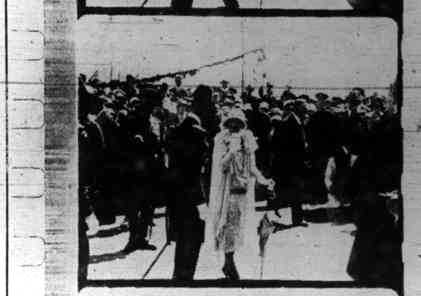
Image courtesy of the National Library of Australia
|
This is not the only problem with the modern copies of this film. The original phonofilm sound recorder was positioned above the camera proper, so that the soundtrack is recorded on the film (longitudinally) behind the corresponding image. (And for projection, the sound pick-up is above the image projector.) In the standard modern system, the soundtrack is ahead of the image. This difference in the position of the sound recorder and pick-up has not been accounted for on the NFSA's access copies of the film, and the soundtrack has not been appropriately moved forward on the film, with the result that there is a delay of about a second between an action and its accompanying sound.
H.M.S. Renown Marine Band at Taronga Park, Sydney
On the afternoon of the following day, Sunday, 27 March 1927, the marine band of the H.M.S. Renown played a concert in the bandstand at Taronga Park, on the north side of Sydney Harbour. The De Forest Phonofilms team was there, and filmed, with sound, some of the performance of the band.
No microphone is obviously visible in the scenes of the band playing: was it intentionally hidden from the camera's view?
In the modern copy of the film, where the behind variable-density soundtrack has been replaced with an ahead variable-area one, the sound is very obviously not synchronised with the picture, for the reason described above.
Descriptions of the scenes in the film
-
TARONGA PARK
Sydney's
Beautiful Zoological Gardens
overlooking
The Magnificent Harbour.
There is a long pan from east to west over the grounds of Taronga Park,
with the harbour in the background.
Various animal enclosures of the zoo are seen.
There is no sign of H.M.S. Renown on the harbour.
This is silent.
-
Selections by
H.M.S. "RENOWN"
MARINE BAND.
TARONGA PARK, SYDNEY.
Overhead shot of the bandsmen walking through a dense crowd.
This is also silent.
- Another silent shot of the bandsmen.
-
Death of Nelson.
We hear the band playing.
The sound is not correctly synchronised, starting about 1 second after the
corresponding image.
This portion of the film has deteriorated, and there is much degradation of the
image as well as the sound to some extent.
-
Selection from
"No, No, Nanette."
The camera starts pointing at the bandstand and during the playing of the tunes,
slowly pans to the right over the crowd, and then returns for the end of the music.
Many of the people stare at the camera.
When the music stops applause is heard.
The sound is not synchronised.
-
God Save the King.
A fixed view of the band playing the National Anthem.
People in the crowd lift their hats.
Again there is applause at the end.
The sound is not synchronised with the image.
Screenings of these films
TARONGA PARK Sydney's Beautiful Zoological Gardens overlooking The Magnificent Harbour.There is a long pan from east to west over the grounds of Taronga Park, with the harbour in the background. Various animal enclosures of the zoo are seen. There is no sign of H.M.S. Renown on the harbour. This is silent.
Selections by H.M.S. "RENOWN" MARINE BAND. TARONGA PARK, SYDNEY.Overhead shot of the bandsmen walking through a dense crowd. This is also silent.
Death of Nelson.We hear the band playing. The sound is not correctly synchronised, starting about 1 second after the corresponding image. This portion of the film has deteriorated, and there is much degradation of the image as well as the sound to some extent.
Selection from "No, No, Nanette."The camera starts pointing at the bandstand and during the playing of the tunes, slowly pans to the right over the crowd, and then returns for the end of the music. Many of the people stare at the camera. When the music stops applause is heard. The sound is not synchronised.
God Save the King.A fixed view of the band playing the National Anthem. People in the crowd lift their hats. Again there is applause at the end. The sound is not synchronised with the image.
The first time the two films described above were shown was on 6 April 1927 at the opening of De Forest Phonofilms' new studios in the old tramway powerhouse building at Rushcutters Bay, Sydney.
The film made at the landing ceremony does not appear to have been shown publicly, probably because the Duke's speech was inaudible and because the dubbed version is easily seen (and heard) to be a deception. The film made of the Renown band, however, may have been shown at Melbourne's Majestic Theatre as part of a season of phonofilm supports in July and August 1927.
A combination of the two films – the welcoming ceremony and the Renown band scenes, both of which were long believed lost – was discovered in the British Film Institute's collection in March 2004 by British film researcher Tony Fletcher, with the assistance of David Pierce of the BFI.
Other Australian phonofilms
There is a single mention of a phonofilm taken during the afternoon of Tuesday, 29 March 1927 at the Sydney Cricket Ground at the exhibition given by school children to the Duke and Duchess of York. No further detail is given, and Stanley Hawkins does not mention it in a later interview, so it is questionable that such a film was really made.
At the official opening of the new De Forest Phonofilms studios
at Rushcutters Bay, Sydney on Thursday, 6 April 1927 the speech of
Herbert Edward Pratten, Federal Minister for Trade and Customs, was phonofilmed.
This speech was broadcast on Sydney radio station 2FC.
The radio programmes for the day also listed, for three-quarters of an hour later,
a reproduction of Mr. Pratten's speech, which will be broadcast as the film
is shown in synchronisation
:
did Phonofilms really manage to develop and print the film in that interval,
and then show it, with the sound being put to air?!
(It was, apparently, the intention of the De Forest Phonofilm Company to cement
into the walls of the studio
a copy of the film of Pratten's speech.
If this did take place the film was not reported found when the building was
demolished.)
The phonofilm made at the opening of Federal Parliament House at Canberra is treated separately.
Notes
[1] In part of scene number 3, the Duke of York is on the very left side of the frame. Because the NFSA's access copy is cropped, we miss seeing some images of the person who is the major character in the film.
[2] I complained about this to a so-called Senior Curator at the NFSA and was sent the following in explanation:
So the removal of 25 % of the image is only "moderate"! (And what criteria were used to decide which portions to remove?) As this film is the first made in Australia with sound-on-film and of undeniable historic importance, one would not expect to see such damage intentionally done to it.On the matter of the DVD access copy, as we discussed, there is the basic ratio adjustment which occurs with some minimal cropping and which varies slightly from screen to screen. Bearing in mind that you are already looking at the equivalent of the gated projected image, this means that there will unavoidably be some reduction in overall image. I have looked at the DVD with you[r] "25% cropping" comment in mind and think that the gated image issue is one which you need to take into account when viewing such reference copies. The overall reduction in image on this basis is moderate.
Why is this "one size fits all" – in this case aspect ratio – attitude inflicted on us? Old films with old (pre-standard) aspect ratios should be presented with these original aspect ratios, even if this requires letterboxing or pillarboxing when telecineing.
[3] Details at http://acms.sl.nsw.gov.au/item/itemDetailPaged.aspx?itemID=7527.
[4] At one point in the film The Arrival of Their Royal Highnesses the Duke and Duchess of York: Sydney, 26 March 1927 (NFSA title number 793), which is one of the Australian Government's Something about Australia series, Sully, in the background, is seen to move from behind his camera and his face is clearly visible for several seconds.
|
Copyright © 2011 – 2013 Tony Martin-Jones | FILM HISTORY INDEX |
Edition 2·1 (2013-05-14) [First edition in 2011-07] |